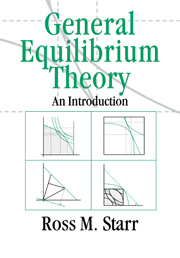Book contents
- Frontmatter
- Contents
- List of illustrations
- Foreword
- Preface
- Table of notation
- A Getting started
- B An economy with bounded production technology, supply and demand functions
- 4 Production with bounded firm technology
- 5 Households
- 6 A market economy
- 7 General equilibrium of the market economy with an excess demand function
- C An economy with unbounded production technology, supply and demand functions
- D Welfare economics
- E Bargaining and equilibrium: The core
- F The scope of markets
- G An economy with supply and demand correspondences
- H Conclusion
- Bibliography
- Index
4 - Production with bounded firm technology
Published online by Cambridge University Press: 05 June 2012
- Frontmatter
- Contents
- List of illustrations
- Foreword
- Preface
- Table of notation
- A Getting started
- B An economy with bounded production technology, supply and demand functions
- 4 Production with bounded firm technology
- 5 Households
- 6 A market economy
- 7 General equilibrium of the market economy with an excess demand function
- C An economy with unbounded production technology, supply and demand functions
- D Welfare economics
- E Bargaining and equilibrium: The core
- F The scope of markets
- G An economy with supply and demand correspondences
- H Conclusion
- Bibliography
- Index
Summary
Firms and production technology
We will represent production as organized in firms. A firm is characterized by its name, by the production technology to which it has access, and by who owns it, the shareholders. We postpone discussion of the ownership and distribution of profits to Chapter 6. The population of firms is the finite set F, indexed j = 1, …, #F. The typical firm is j ∈ F. Firm j's most distinctive characteristic is its production technology, represented by the set yj ⊂ RN.
The set yj represents the technical possibilities of firm j. A typical element y of the technology set, y ∈ yj, is a vector representing a technically possible combination of inputs and outputs. Negative coordinates of y are inputs; positive coordinates are outputs. For example, say y ∈ yj, y = (-2, -3, 0, 0, 1); this y ∈ yj means that an input of two units of good 1 and three units of good 2 will allow firm j to produce one unit of good 5. Each element y of yj is like a recipe in a cookbook or one of many blueprint plans for production, which can be implemented as a matter of choice by the firm. There is no guarantee that the economy can provide the inputs y ∈ yj specifies, either from endowment or from the output of other firms. Rather, y ∈ yj represents the technical output possibilities of production by firm j if the specified inputs are provided.
Information
- Type
- Chapter
- Information
- General Equilibrium TheoryAn Introduction, pp. 73 - 79Publisher: Cambridge University PressPrint publication year: 1997
